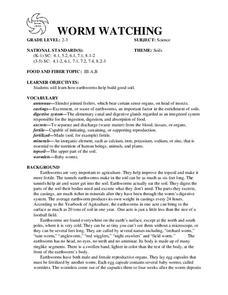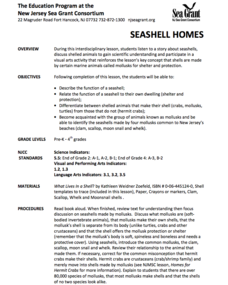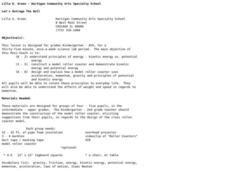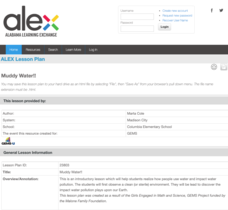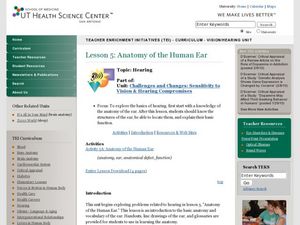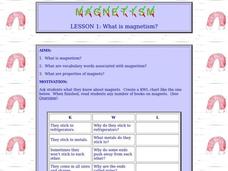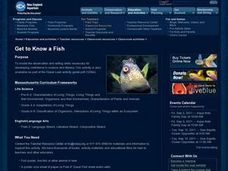Curated OER
Endangered Species
Young scholars define extinction, name four animals and two plant species that are extinct, list three reasons why animals and plants become extinct, and create ways that would help prevent extinction.
Curated OER
A Hidden Beauty
Expose the beautiful mystery of bulbs as young botanists learn all about these fascinating plants. They glean information from a short text before observing actual bulbs (consider an onion), and comparing their findings with predictions....
Curated OER
Through the Eyes of an Owl
Students describe vertebrates in terms of observable body parts and characteristics and describe life cycles of familiar organisms. They identify familiar organisms as part of a food chain or food web and describe their feeding...
Curated OER
Beautiful Butterfly Tiles
Third graders create a butterfly drawing that includes the elements of art and principles of design. They create artwork that can be made into ceramic tiles to be installed around the classroom doorways in our new addition.
Curated OER
Fossils and our Past (part 1 of 3)
Third graders investigate how some extinct organisms resemble organisms that are still alive today. They watch and discuss the Magic School Bus video about fossils, then create clay fossil imprints, matching the imprints to plaster of...
Curated OER
WORM WATCHING
Students investigate how earthworms help build good soil. They examine the worms carefully to find the ringlike segments and swollen band at the front of the earthworm's body. Students take turns dampening the soil every day and adding...
Curated OER
THE WONDERFUL WATER CYCLE
Students are introduced to the processes of evaporation and condensation as they observe physical changes in water. They observe how matter changes from a solid to a liquid state. Students are explained that steam is water in its gaseous...
Curated OER
Penguins Nesting Know-How
Learners maintain a field journal as they follow penguin parents raising their chicks during the breeding season. They formulate testable questions. Students reflect on animal behavior in the field related to survival and chick rearing.
Curated OER
Topography of Africa
Young scholars study Africa's diverse landscape and investigate how these features impact the available water supply, food sources, and population distribution of the continent. They compare topographical features and
their affect on...
Curated OER
Seashell Homes
Pupils listen to a story about seashells. They discuss shelled animals. Learners describe the function of seashell. Pupils relate the function of a seashell to their own dwelling. They differentiate between shelled animals that make...
Curated OER
Diffusion of Molecules
Students conduct a series of experiments to observe factors that impact molecular movement. In this molecular chemistry instructional activity, students drop food coloring in water with different properties (hot, with ice, with alcohol)...
Curated OER
Let's Outrage the Bull
Students study kinetic and potential energy. In this energy lesson, students in grades K-2 understand the differences between kinetic and potential energy. Students in grades 3-5 demonstrate that kinetic and potential energy. Students in...
Curated OER
What is an Atom?
Third graders understand that the smallest particle is an atom. In this matter instructional activity, 3rd graders make a piece of aluminum smaller and smaller to see that what's left is still aluminum. Students recognize that cutting...
Alabama Learning Exchange
Effects of Friction on a Moving Block
Students investigate how friction affects the movement of a block across surface areas. They test five different kinds of surfaces—smooth surface, wax paper, a paper towel, course, and fine sandpaper. They predict and record the results...
Alabama Learning Exchange
The Rockin' Rock Cycle: Metamorphic Rocks
Students study the formation of metamorphic rock. In this metamorphic rock lesson, students examine how metamorphic rock forms as part of the rock cycle. They review the rock cycle using chocolate chips, conduct Internet research, and...
Alabama Learning Exchange
Making and Observing Life in a Terrarium
Young scholars understand the parts of the terrarium and why they are important in establishing an ecosystem. In this ecosystem lesson, learners recall background information on aquariums, terrariums and the water cycle. Young scholars...
Alabama Learning Exchange
Muddy Water!!
Investigate water pollution. Learners start out by completing the know and want to know portions of a KWL chart on water pollution. They read a story that stimulates thinking about water pollution and view an online resource related to...
Alabama Learning Exchange
Are We Finished with It Yet?
Learners recognize the importance of natural resources and that we need to conserve, reuse and recycle them. In this conserving natural resources lesson, young scholars are given one object and must create something with it. Young...
Curated OER
Anatomy of the Human Ear
Students examine the human ear and its function. In this anatomy of the human ear lesson plan, students view drawings of the ear and learn about the structure of the ear through handouts and glossaries. This lesson plan is part of a...
Curated OER
Minerals
Students define the characteristics of a mineral. In this geology lesson, students are given out various materials to observe such as a chicken bone, salt shaker, white paint, and chalk. Students categorize the items and are told what...
Curated OER
What is Magnetism?
Young scholars investigate magnetism. In this physics lesson, students create a KWL chart about magnetism and research various suggested websites to find out more about magnetism. Young scholars log on to the "BrainPOP" website and view...
Curated OER
Parts of a Tree
Learners identify four parts of trees. For this plant biology lesson, students read the book Trees and conduct Internet research to identify the parts of the tree. Learners take notes from each website and complete an included worksheet.
Curated OER
Get to Know a Fish
Students discover the anatomy of a fish by identifying its body parts. In this oceanography lesson, students view a live fish in their classroom and draw a poster of the fish one body part at a time while identifying it. Students...
Curated OER
Simple/Complex Machines
Students make a simple machine. In this physics lesson, students learn about six types of simple machines and the purpose of each and brainstorm examples of simple and complex machines in the classroom. Students create a simple or...
Other popular searches
- Space Science Vocabulary
- Earth Science Vocabulary
- Food Science Vocabulary
- Science Vocabulary Games
- Vocabulary Forensic Science
- Physical Science Vocabulary
- Life Science Vocabulary
- Science Vocabulary Portfolio
- Vocabulary Exercises Science
- Science Vocabulary Puzzle
- Science Vocabulary Lesson
- Science Vocabulary Polymers







